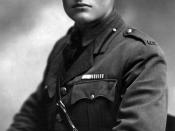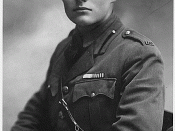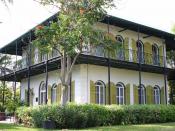Hemingway begins his story of war with a seemingly peaceful portrait of an Italian village in the summer and autumn of 1916. His rich visual images evoke a natural world that appears at first glance to be changeless. The narrator is merely an observer of the shifting seasons and the apparently distant war. Hemingway says a lot by saying little, and his technique is easily seen in this opening chapter. Although he is writing of war, he doesn't dwell here on gore or glory; fighting is merely "not successful," things are going "very badly." The language is emptied of passion, as if the narrator had already suffered so much that he had lost the capacity to feel pain.
Notice, though, how carefully the descriptions are worked out to show the despair below the surface. Though the setting is placid and lovely, each glimpse of nature is interrupted by the war.
The dust raised by marching soldiers coats the trees; the mountains above the plain "rich with crops" glow with artillery flashes that look like summer lightning. The war has warped the seasons. The fall comes too early, too harshly: the trees lose their leaves too soon, the country quickly becomes "dead with the autumn." In particular, keep the rain in mind, for you'll see it repeated throughout the book. This is not a fertilizing spring shower, but a cold autumn rain, associated with sickness and death. And note the simile describing the troops loaded with equipment under their rain capes. They "marched as though they were six months gone with child"- not just six months pregnant, but "gone," the seemingly casual word choice is in fact a portent of the deaths of many of these soldiers and of the death in childbirth of Catherine Barkley.
The dominant tone is...


